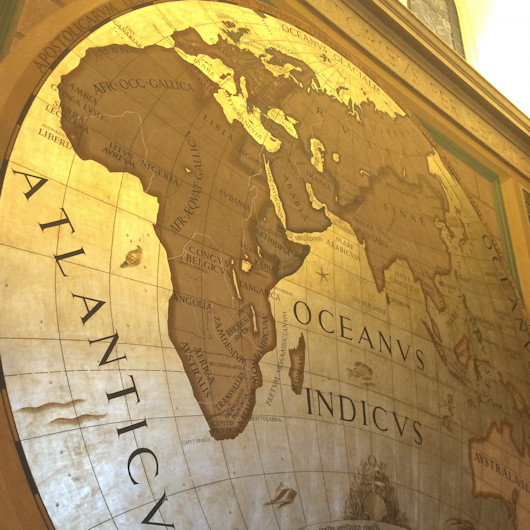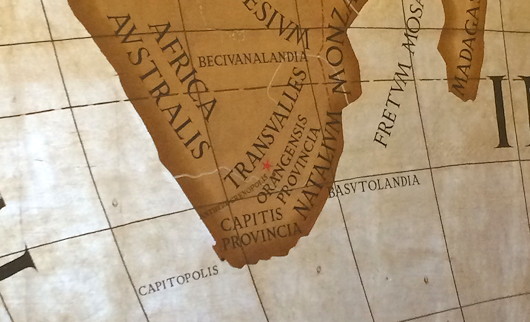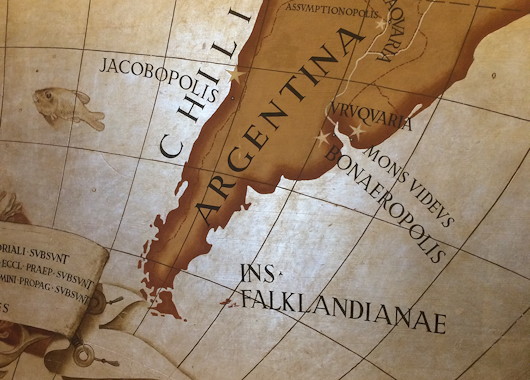
About Andrew Cusack
 Writer, web designer, etc.; born in New York; educated in Argentina, Scotland, and South Africa; now based in London.
Writer, web designer, etc.; born in New York; educated in Argentina, Scotland, and South Africa; now based in London. read more
News
Blogs
Reviews & Periodicals
Arts & Design
World
France
Mitteleuropa
Knickerbockers
Argentina
The Levant
Africa
Cape of Good Hope
Netherlands
Scandinavia
Québec
India
Muscovy
Germany
Academica

No ‘Malvinas’ Here
Some difficulties of Latin place names in 1930s cartography
It’s no great secret I’m a lover of maps. When calling in to the Secretariat of State on the terza loggia of the Apostolic Palace in the Vatican the other day, I was very pleased to see the cartographic murals there, including the two hemispheres done by Ignazio Danti in the 1580s. Moving to the next interior offices, however, the visitor is greeted by a much more recent mappa mundi, dating from the 1930s, replete with the glamour of empire’s heydey.
As you might expect, I quickly gravitated to South Africa, where the Latin of whichever particular interwar geographer it was aroused particular curiosity. He rendered Cape Town as ‘Capitopolis’ where perhaps more properly it should be ‘Civitas Capitis’ (or much more rarely ‘Urbs Promontorii’). Civitas Capitis is the name of the Archdiocese, and as the Church is, in a sense, the chief extant authority on Latin, there is an argument for favouring Vatican usage of Latin toponyms. Sometimes, as in the case of Cape Town, they try to use Latin words to approximate the name of the place. Other times, such as with Bloemfontein, they simply use the name as it is (rendering it with appropriate Latin word endings as required).

But looking at Bloemfontein on the map, we see the curious name of ‘Antherogrenopolis’, a Latin toponym I had never heard before and which the Archidioecesis Bloemfonteinensis doesn’t use. Bloemfontein is an Afrikaans placename meaning ‘spring of flowers’ or ‘blooming spring’, but ‘anthero-’ presumably refers to the anther which is merely part of the stamen of a flower, while the ‘greno-’ bit I’ve no idea. (Perhaps a proper Latinist can advise?) I would think something along the lines of Florifonsopolis might be a much closer approximation to Bloemfontein.
Also they seem to have attributed to Bloemfontein the status of capital city, neglecting the more appropriate candidates of Pretoria (the executive capital) and Cape Town (the seat of the parliament). Bloemfontein is merely the seat of the Supreme Court of Appeal. As such it was the undisputed judicial capital from 1910 until the 1990s when the Constitutional Court was set up in Johannesburg. Does this mean South Africa, which previously had three capitals (executive, legislative, and judicial) now has four?
More satisfying was looking towards a certain archipelago in the South Atlantic and seeing it under its perfectly correct name: Insulae Falklandianae.

Search
Instagram: @andcusack
Click here for my Instagram photos.Most Recent Posts
- In the Courts of the Lord February 13, 2025
- American Exuberant February 10, 2025
- Crux Alba Journal Launch February 10, 2025
- The Year in Film: 2024 February 10, 2025
- Articles of Note: 27 January 2025 January 27, 2025
Most Recent Comments
- on When an American aristocrat meets a European Grand Duke
- on The Year in Film: 2024
- on Jesuit Gothic
- on The Borough Synagogue
- on No. 82, Eaton Square
- on Christ Church
- on The Last Will and Testament of Louis XVI
- on Amsterdam
- on Season’s Greetings from the Seventh
- on Season’s Greetings from the Seventh
Book Wishlist
Monthly Archives
Categories



Did you by any chance notice the borders shown for Germany? This would tell us whether the map is early or late 1930s.
I believe it’s not Antherogrenopolis, but Antherocrenopolis, the elements being ἀνθηρός, “flowery, flowering, blooming”, and κρήνη, “well, spring, fountain”.
Gregor has undoubtedly solved that little problem.
I wonder if the future Cardinal Antonio Bacci may not have been the inventor of these latinized place names. He was appointed Secretary of Briefs to Princes in 1931, and was just the man to turn his hand with delight to this sort of trifling task. His Lexicon Eorum Vocabulorum Quae Difficilius Latine Reddunter gave less than felicitous if often intentionally (one hopes) amusing “translations” of terms popular in the 1960s but mercifully long forgotten; my favourite is “barbara saltatio” for “the twist” (does anyone under forty know what that was?).
Anyway, he thoroughly redeemed himself when he joined Cardinal Ottaviani in signing the so-called “Ottaviani Intervention” (written in fact by Fr M. L. Guerard des Lauriers OP), which correctly denounced the Novus Ordo Missae for the shameful simulacrum it was and is.
Many thanks, Gregor — that makes perfect sense!
Cardinal Bacci sounds a splendid fellow. Time his Lexicon was re-issued!
And I can attest to being both a) under forty and b) knowing what the barbara saltatio, as I feel we must now call it, is. But I admit I am probably not a representative sample of the under-forty population.
Please, somebody could info me about the author of the 1930’s mappa mundi in Vatican Terza Loggia? That were Antherocrenopolis is written? I need to find a complete, accurate image of it, to put in a novel of mine? I would be very grateful to you.
Please, if someone has the answer, the author of this mappa mundi of 1930’s, and a site were to find more accurate photos, contact me at this email: re_pavone@hotmail.it
Thank you.